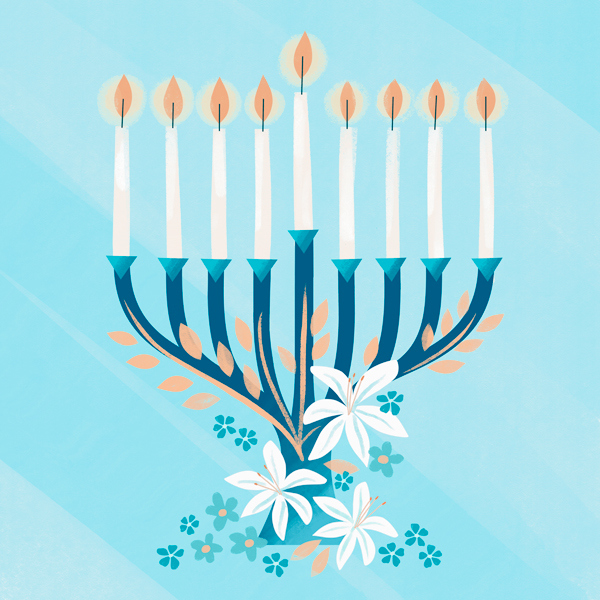Dreidel
A major activity on Hanukkah is playing Dreidel; a game featuring a spinning top and gelt, which often comes in the form of chocolate gold coins, but other tokens can be used. Lauren’s family used marbles, candy, or pennies for the kids, and bigger bills for the adults. Here’s how to play:
- You need two or more players, plus a dreidel and gelt to divide evenly
- To start the game, each player puts one token in the pot
- Each player takes a turn spinning the dreidel; there are four Hebrew letters which will tell players what to do on their turn: Nun (do nothing), Hei (take half of the pot), Shin (add one token to the pot) and Gimmel (take the whole pot)
- Whenever the pot is emptied, or there’s only one piece left, each player adds a token to the pot
- After each player has had their turn, they add a token to the pot to start a new round
- Players are out when they are out of tokens
- The game ends when one player has all of the tokens
There are many different resources for adding a twist to the way you play. A quick search will lead you to a Dreidel board game, Speed Dreidel, “Staccabees,” ways to combine Dreidel with other popular board games, Dreidel with betting and more.
Debi’s family always had dreidels around “to see who could spin the longest,” but didn’t play very much. “We mostly played the actual game during Hebrew school,” she said.
Lauren’s family, however, loves playing the actual game. “My parents, brother and I are a big game night family as it is, and also naturally love making little bets with each other—over random trivia or history facts, etc.,” Lauren said. “So playing dreidel, which is in essence a gambling game, is something we have always enjoyed! Lots of friendly competition in our house, though witnesses have argued it’s not always that friendly.”
When it comes to the dreidels themselves, lots of families are collectors. “My mom collects dreidels of all kinds—from tiny plastic ones meant for kiddos to high-end sculpted ones meant for decor,” Lauren said. “Personally, I’ve forever been on the hunt for Hanukkah decor that feels ‘non-kid’—though now that I’m a mom, I’m all about the kid-friendly craft projects and decor, too!”
How Dreidel is tied to Hanukkah
“Hanukkah” comes from the Hebrew word “hinuch” which translates to “to teach.” This is significant because of the Jews’ commitment to their faith—Dreidel was invented as a distraction method so they could stealthily read scripture when Syrian-Greek soldiers were around. However, the word “Hanukkah” itself means “dedication.”
DIY Hanukkah projects for kids
Kaila S., a 25-year-old teacher who taught at Jewish private schools Kadima Day School and Ilan Ramon Day School for two years, shared some Hanukkah activities that proved popular in the classroom.
Hodgepodge menorahs
“For a first activity, families could collect recyclables (preferably nothing made of cardboard or paper) and they could create a handmade hanukkiah. Nuts—as in nuts and bolts—make great candle-holding equipment (especially if you use little birthday candles), and children could use Legos, building blocks, wood, clay, rocks, paint or tiles to create a base. An adult should handle the hot glue gun, but otherwise, let their creativity run wild with this craft.”
Clay and paper dreidels
“The students have the opportunity to play Dreidel throughout the holiday, and it is a great way to build comradery, respectful discourse, and counting skills!” Kaila said. “Many people choose to make dreidels out of paper or clay. I would suggest baking clay over air-dry clay, and children could paint the clay after. Crayola actually has a printable for making a 3D paper dreidel, which children could colour first, then cut out and assemble with a little bit of adult assistance.”
Assembly line latkes
“We would create an assembly line of latkes, and this can also be done at home. Children clean the potato and then use a cheese grater to carefully cut the potato into little chunks. Then they gather the chunks and add them to a bowl with eggs, seasoning and matzo meal. An adult will need to fry the latkes in oil and then serve.”
Gratitude gifting
“Hanukkah is a season of gift giving, and typically the children do all the receiving, so in class I like to do a giant art project for them to gift to their families,” Kaila said. “We create a calendar for the new year, and the children create art for each month. This is a great way to teach about seasons and other holidays throughout the year as well. This is a huge project, but any craft that allows children to be a part of the gift giving is a great way to teach gratitude.”
